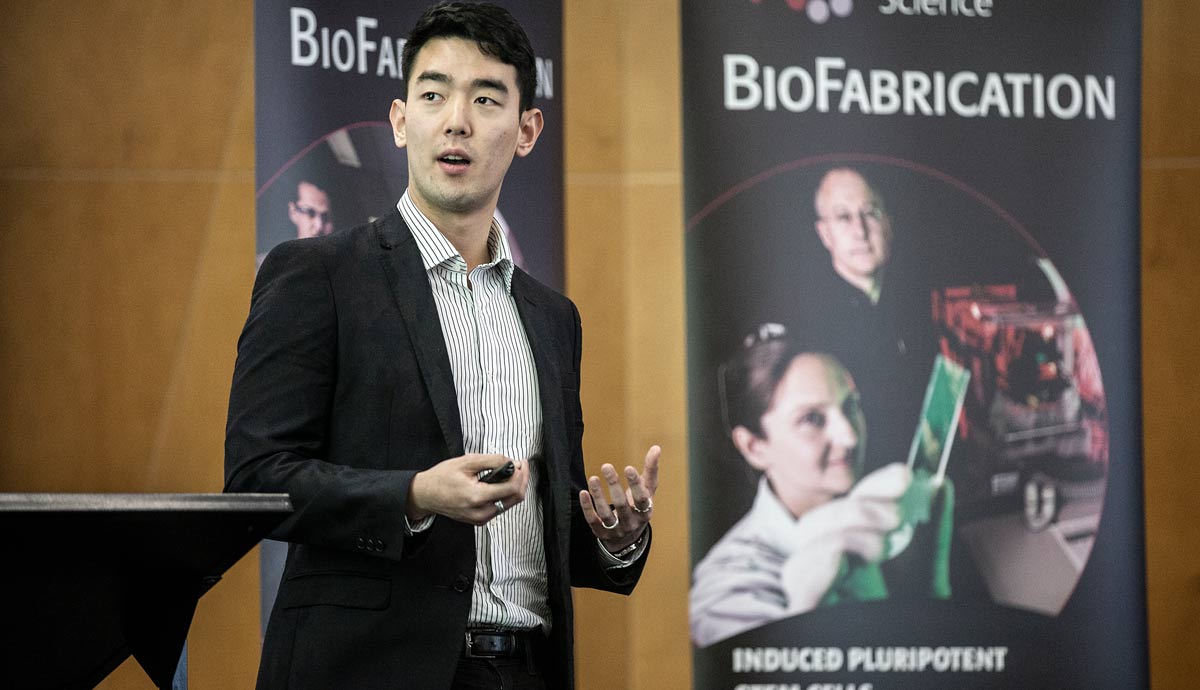June 14, 2018
Fast-tracking new solutions for wound healing
Industry roadshow to highlight opportunities for translating research to the hospital ward
Research, clinical and industry partnerships are fast-tracking 3D-printing techniques and materials for wound healing, improving patient outcomes and reducing the burden on the health system as well as creating opportunities for Australian manufacturers.
A review of the latest developments in 3D printing and cell therapy for wound healing, published recently in the journal Advances in Wound Care, highlights how 3D printing is being used to fabricate tissue-like products that mimic the structure and function of human skin.
Professor Gordon Wallace, review co-author and Director of the University of Wollongong (UOW) headquartered ARC Centre of Excellence for Electromaterials Science (ACES), said treating skin tissue damaged by burns and other trauma, diabetes or vascular disease was a major challenge and a burden on healthcare systems.
“While several advanced skin graft treatments exist, they are costly, come with risks such as host rejection, excessive scarring and potentially disease transmission, and are limited to treating shallow wounds where formation of blood vessels is less important,” Professor Wallace said.
“Combined with the emergence of 3D printing tools and techniques, biofabrication of tissue materials from biologically compatible materials offers the possibility of not only reducing availability and cost of treatment, but also the prospect of treating deep wounds comprising several tissue layers.”
The layered fabrication method could also accommodate the use of wound healing proteins, stem cells and anti-inflammatory drugs during the printing process, as well as creating more complex tissue structures that could eventually include vascular networks that facilitate oxygen and nutrient exchange to hair follicles and sweat glands
Dr Chris Baker, a head of dermatology at St Vincent’s Hospital Melbourne working with ACES on clinical trials, said that while the biological complexities of human skin are relatively well understood, appropriate repair mechanisms are scarce and often costly.
“The technology and underpinning materials science we’re developing with ACES has the potential to be deployed in hospitals and wound clinics, producing replacement tissue for wounds on-demand and at the quantity needed,” Dr Baker said.
“That has huge potential benefits for patient recovery and their quality of life after skin loss or damage from any cause.”
ACES and Venus Shell Systems (VSS), a South Coast New South Wales marine biotechnology producer, are hosting the first in a series of national workshops bringing together material scientists, tissue engineers, and clinicians with small to medium enterprises to explore commercial opportunities based on the latest research and development highlight
The workshop will highlight how the partnership between ACES and VSS has led to the development of bio-inks from seaweed, which are being accelerated through collaboration with clinicians at St Vincent’s Hospital Melbourne.
VSS was started in 2014 to create a market for seaweed cultivation. It has been a long-term partner with ACES in developing biocompatible gels, such as the bio-ink, for 3D printing and regenerative medicine.
VSS Director and Chief Scientist Dr Pia Winberg said seaweed extracts contain molecules that are similar to the connective tissue in human skin.
“Gel molecules taken from seaweeds are ideal candidates for medical implants and tissue engineering because they provide the necessary structural support and have also been found to act as a frontline defence and communication system in supporting or inhibiting the interaction with microorganisms such as viruses, bacteria and fungi,” Dr Winberg said.
“These gels are highly cell compatible and even stimulate the health and development of human stem cells, so in the instance of looking for new polymer materials for medical implants, seaweed extracts are a key candidate.”
The workshop, supported by funding from MTPConnect – the Medical Technologies and Pharmaceuticals Industry Growth Centre – will be held at UOW’s Innovation Campus, is designed to help small to medium enterprises connect with researchers to develop commercial opportunities from bioprinting and the growing field of regenerative medicine.
Professor Wallace said events such as the workshop are vital in bringing together the people to solve challenges around more advance bio-inks and fabrication techniques.
“The creation of complex skin tissue constructs will need to work on challenges around microvascularization, integration of multiple cell types, and skin appendages. Progress towards those elements requires close interactions between material scientists, tissue engineers, and clinicians.”
